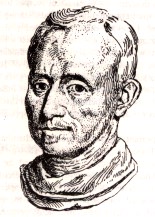Johann
Baptista van Helmont
1579
- 1644
Noble
roots. Johann Baptista van Helmont was
born in 1579 in Brussels, Belgium to a noble family. Van Helmont
studied arts at Louvain until 1594, but did not complete a degree.
He next attended the Jesuits' school at Louvain, but left there dissatisfied.
From there he studied the works of the mystics and finally turned to the
study of medicine. After reading and studying the works of Hippocrates,
Galen, Avicenna, van Helmont expressed dismay at the lack of useful information
they contained. ....all seemed certain and
incontrovertible..... the years I had spent were altogether fruitless."1
Van Helmont obtained his MD in 1609
at Louvain.
|

|
On
Marriage and Chemistry. In 1609,
van Helmont married Margaret van Ranst, also from nobility. Of her,
he wrote:
"God
has given me a pious and noble wife. I retired with her to Vilvorde
and there for seven years I dedicated myself to pyrotechny and to the relief
of the poor."1
Another account
says:
"[Van
Helmont was] wholly taken up in chemical operations night and day.... he
was scarce known in his neighborhood.... nor scarce ever stirr'd out of
doors."1
From
Alhemist to chemist. Van Helmont
represents the transformation between alchemy and chemistry. For
example, he believed in magic and claimed to have used a small piece of
the philosophers stone to convert mercury into gold. On the other
hand, Van Helmont was one of the earliest to use the balance in his chemical
work and he believed in the indestructibility of matter. A century
later, the significance of accurate measurements was still not widely appreciated.
Van Helmont knew that metals could be dissolved with acids ('concealed
in solution') and reproduced, such as by reaction with another metal.
He established that metals were not destroyed by acid. Van Helmont
referred to himself as a 'philosophus per ignem' (philosopher by fire).
He valued experimental work over philosophical reasoning.
On
Aristotle and Water. Van Helmont
rejected the Aristotelian theory of four elements, however, he agreed that
air and water were elements. Air's role was to enhance fires and
water, therefore, was the basis for all else. His famous willow tree
experiment 'proved' that water could be converted into other forms of matter.
Van Helmont planted a willow tree in a weighed amount of earth. After
watering it faithfully for five years, van Helmont found that while the
tree had gained 164 pounds, the weight of soil was not diminished.
This proved to him that the tree represented water transformed into another
substance.
Wild
Spirit. Van Helmont was the first
to consider the production of gases during chemical reactions. He
coined the word 'gas' — possibly from the word 'chaos.'2
He also noted that gases can explode glass containers and can be condensed
into liquids.
"Suppose
thou, that 62 pounds of Oaken coal, one pound of ashes is composed: Therefore
the 61 remaining pounds are the "wild spirit" which, also being fired,
cannot depart, the Vessel being shut. I call this spirit, unknown
hitherto, the new name of 'gas,' which can neither be retained in Vessels
nor reduced to a visible form, unless the seed is first extinguished."3
"[If
nitric acid is poured on sal ammoniac in a glass vessel which is closed
by cement or by melting the glass,] the vessel is filled with plentiful
exhalation (yet an invisible one) and however it may be feigned to be stronger
than iron, yet it straightway dangerously leapeth asunder into broken pieces."1
[...gas
is composed of invisible atoms which can come together by intense cold
and condense into minute liquid drops.]1
Gases
described by van Helmont. Van Helmont's
extensive study of gases has earned him the honor of being called 'the
real father of pneumatic chemistry.'4
Some credit him with the discovery of carbon dioxide (which he called gas
sylvestre). In all, he investigated and categorized a long list of
gases, including:
• gases
evolved from spa water [now known to be CO2]
• gases produced
by burning charcoal [CO2 and
CO]
• gases that
form in cellars where wine is fermenting [CO2]
• gas from eructions
(belches) [CO2]
• the poisonous
gas that collects in mines [CO2]
• poisonous
red gas [NO2] that is formed
when aqua fortis (HNO3) on silver
• gas evolved
from aqua fortis (HNO3) and sal
ammoniac (NH4Cl) in the cold
[Cl2]
• sulfurous
gas that 'flies off' from burning sulfur [SO2]
• gases from
burning gunpowder which burst closed vessels [CO2,
H2O and SO2]
• intestinal
gas which is flammable [H2, CH4,
H2S and impurities]
• gases evolved
in putrefaction [H2, CH44,
H2S, organic amines and many
others]
Lived
to age 65. At age 60 van Helmont
described a near-death experience in which he accidentally poisoned himself
with gases from burning charcoal. The symptoms given suggest he had
CO poisoning. Van Helmont died December 30, 1644.
Lasting
accomplishments.
• use
of the balance and belief in the conservation of matter
• first to recognize
and characterize gases, coined the word 'gas.' (The word 'gas' was not
used in England until the 19th century because Robert Boyle used the word
'air' in the context of various types of 'air.'
• His 1648 book Ortus
medicinae established van Helmont as an instrument of transition from alchemy
to chemistry. Robert Boyle was influenced by van Helmont's work.
This book collection of van Helmont's work, assembled and edited by his
son four years after van Helmont's death.
References.
1 A Short History
of Chemistry, J. R. Partington, 3rd edition, (1957)
2. The Historical
Background of Chemistry, H. M. Leicester, Dover, 1956.
3 Oriatricke,
or Physick Refined, van Helmont, English language edition, 1662.
4 A Source Book
in Chemistry 1400 - 1900, H. M. Leicester, H. S. Klickstein, Harvard
University Press, 1968.

(This page last updated 25 September
2001)